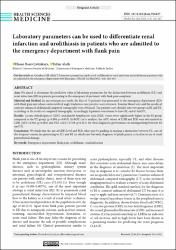Laboratory parameters can be used to differentiate renal infarction and urolithiasis in patients who are admitted to the emergency department with flank pain

Göster/
Erişim
info:eu-repo/semantics/openAccessAttribution-NonCommercial-NoDerivs 3.0 United Stateshttp://creativecommons.org/licenses/by-nc-nd/3.0/us/Tarih
2021Üst veri
Tüm öğe kaydını gösterÖzet
Aim: We aimed to determine the predictive value of laboratory parameters for the distinction between urolithiasis (UL) and renal infarction (RI) in patients presenting to the emergency department with flank pain complaint. Material and Method: In our retrospective study, the files of 73 patients who presented to the emergency department (ED) with flank pain and whose costovertebral angle tenderness was positive were reviewed. Routine blood tests and the results of contrast-enhanced abdominal computed tomography were obtained. The patients were divided into two groups as RI and UL according to the results of computed tomography. Accordingly, 8 patients were found to have RI, and 65 had UL. Results: Lactate dehydrogenase (LDH) and platelet lymphocyte ratio (PLR) values were significantly higher in the RI group compared to the UL group (p<0.001-p=0.045). In ROC curve analysis, the AUC values of LDH and PLR were determined as LDH (AUC=0.983, p<0.001) and PLR (AUC=0.719, p=0.015) for their diagnostic performance in distinguishing between RI and UL. Conclusion: We think that the use of LDH level and PLR value may be guiding in making a distinction between UL, one of the frequent reasons for presenting to ED, and RI, in which rare but early diagnosis of plank pain is critical in terms of renal parenchymal damage.


















